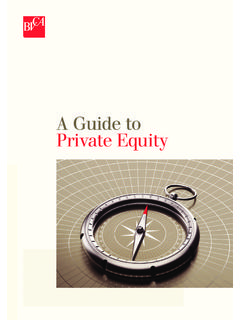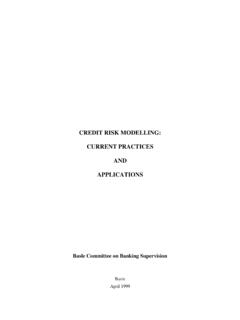Transcription of Risk in Private Equity - BVCA
1 Risk in Private Equity New insights into the risk of a portfolio of Private Equity funds ///// 1 Risk in Private EquityNew insights into the risk of a portfolio of Private Equity fundsOctober 2015Dr. Christian Diller,Dr. Christoph J ckel,Montana Capital Partners2 ///// Risk in Private Equity New insights into the risk of a portfolio of Private Equity funds BVCA Research Paper October 2015 About the authors: Many thanks:We would like to thank Pevera and Preqin for providing their datasets for this analysis. We also would like to thank the BVCA Research committee as well as Gillian Brown (Rubato Associates) for their valuable comments to our paper. Disclaimer:The information contained in this report has been produced by the authors, mcp and BVCA, based on data from the BVCA, Pevera and Preqin and third parties information.
2 While the authors, mcp and BVCA, have made every effort to ensure the reliability of the data included in this report, the organisations cannot guarantee the accuracy of the information collected and presented. Therefore, the organisations cannot accept responsibility for any decision made or action taken based upon this report or the information provided here. This paper also does not represent any investment recommendation or any kind of advice to any institution or Christian Diller, PartnerChristian is a partner and co-founder of Montana Capital Partners AG, a Swiss investment advisor focussed on attractive niches of the secondary market with more than EUR 600 million Assets under Management as well as high quality asset management services for leading and sophisticated was previously Head of Solutions at Capital Dynamics leading the firm s structured activities with assets under management of more than USD 2 billion.
3 He also led the portfolio and risk management activities, advising some of the world s largest investors on asset allocation, portfolio rebalancing, cash flow planning and risk management in Private Equity . Prior to that, he worked in the asset management department covering strategic investments of Allianz Group in industrial, energy and healthcare companies. Before that, Christian was a buy-side analyst at Pioneer is chairman of the EVCA risk management committee developing guidelines for risk management models in Private Equity and was involved in discussions with European regulators on regulation of Private Equity under Basel III and solvency II. He regularly published in high-quality journals, co-authored a book on risk in illiquid assets and speaks at holds a Dr.
4 Rer. pol. in finance specializing on risk-/return characteristics of Private Equity funds from the Technical University Munich and a MSc from the Ludwig-Maximilian University Christoph J ckel, Vice PresidentChristoph is a Vice President of Montana Capital Partners AG. Christoph developed and implemented various risk management systems during advisory projects at large and sophisticated investors with multi-billion portfolios spread over developed and emerging markets. He published articles in high quality scientific and practitioner s journals and presented at various joining mcp, Christoph was a research assistant at the Department of Financial Management and Capital Markets of the Technical University of Munich. His dissertation dealt with the computation and evaluation of alternative expected return proxies for stocks and was partly written during his stay as a Visiting Scholar at UCLA Anderson.
5 In addition, Christoph gained international work experience at Kolbenschmidt Pierburg in Shanghai, Capital Dynamics in Zug, and Lehman Brothers in holds a Dr. rer. pol. in finance from the Technical University Munich and a diploma degree in business administration specializing on capital markets and operations research at the Technical University of Munich and at the National University of in Private Equity New insights into the risk of a portfolio of Private Equity funds ///// 11. IntroductionDue to the specific characteristics of Private Equity investments, the standard risk management tools that are used in other asset classes are unlikely to be applicable. Instead, there are specific risks in Private Equity that an institutional investor should be aware of.
6 In this study , we assess and measure the most significant risks in Private Equity , and examine in detail how these risks can be reduced. We contend that the most significant risks in the asset class are those of market risk, funding risk, liquidity and capital risk, and our empirical analysis of three different Private Equity datasets finds that both funding and capital risk can be substantially reduced through diversification. In the study , we also measure Realisation Risk , an analysis on losing value from the point of observation until the end of fund s life, for the first time in a study on risk analysis in Private Equity . Our results demonstrate that the risk for an investor of losing any capital over the entire holding period with a portfolio of 20 funds is only , reducing to under 1% for an investor with a portfolio of 50 funds, adjusting for capital calls and distributions.
7 These results demonstrate that Private Equity is not as risky as it is often perceived by some market participants, and that risk in the asset class should be conceptualised in a different way than it currently Private Equity has become an increasingly established asset class for institutional investors over recent decades, the issue of risk within the industry remains relatively underexplored. Private Equity is a long-term asset class which generates strong returns for investors, and given the current low interest rate environment, may be particularly attractive to institutional investors who are seeking sustainable Some of the largest pension funds have had positive experiences with Private Equity since the early 1970s and have current Private Equity allocations of around 25%.
8 2 Other long-term, non-regulated investors such as family offices sometimes have even higher allocations to the asset class with a Private Equity allocation comprising more than a third of their total While many of these sophisticated investors value the long-term risk-return characteristics of the asset class, regulators are often perceived as constraining banks and insurance companies from investing into the asset class or forcing them to divest their holdings as they perceive Private Equity as being too risky. Due to its long-term investment horizon, its illiquidity and its unique structural characteristics, Private Equity has its own set of specific risks . These risks differ from those in public markets, and as such, can be more difficult to understand and capture in traditional risk models.
9 As typical risk measures cannot be used and as the average performance is often considered to be higher than in public markets, risk in Private Equity is often perceived as being high. But how risky is Private Equity in reality? What are the risks for investors who invest in a portfolio of Private Equity funds? How can an investor mitigate these risks ? Can an investor lose part or even all of an investment into a portfolio? How high is the risk that an investor does not get back the value that is generated during a fund s lifetime? What factors need to be taken into account when investing into the asset class, and what are the differences with public equities?1 See Cornelius (2011), Chapter See Diller/Wulff (2012), as well as webpages of Washington State Pension Fund (WSIB), CalPERS and OPERF (Oregon Public Employee Retirement Fund) for up-to-date See survey from Montana Capital Partners and Private Equity International 2014 in PEI (2014).
10 2 ///// Risk in Private Equity New insights into the risk of a portfolio of Private Equity fundsThis BVCA paper provides answers to these questions. It starts with a chapter describing the risks of Private Equity investments, which can be categorised into market risk, funding risk, liquidity risk and capital risk. Each risk factor will be defined and examined in detail and a demonstration will be provided on how that risk can be reduced. The main section of the paper focuses on empirical risk analyses for a typical investor when investing into a portfolio of Private Equity funds. We run analyses to show the extent of the market risk, funding risk, liquidity risk and capital risk for an investor. As capital risk (the risk of losing any capital) is one of the most important, we focus on this risk and run various analyses.






